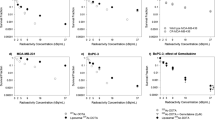Abstract
Twenty-two patients with malignant melanoma were treated with boron neutron capture therapy (BNCT) using10B-p-boronophenylalanine (BPA). The estimation of absorbed dose and optimization of treatment dose based on the pharmacokinetics of BPA in melanoma patients is described. The doses of γ-rays were measured using small TLDs of Mg2SiO4 (Tb) and thermal neutron fluence was measured using gold foil and wire. The total absorbed dose to the tissue from BNCT was obtained by summing the primary and capture γ-ray doses and the high LET radiation doses from10B(n,α)7Li and14N(n,p)14C reactions. The key point of the dose optimization is that the skin surrounding the tumour is always irradiated to 18 Gy−Eq, which is the maximum tolerable dose to the skin, regardless of the10B-concentration in the tumor. The neutron fluence was optimized as follows. (1) The10B concentration in the blood was measured 15−40 min after the start of neutron irradiation. (2) The10B-concentration in the skin was estimated by multiplying the blood10B value by a factor of 1.3. (3) The neutron fluence was calculated. Absorbed doses to the skin ranged from 15.7 to 37.1 Gy−Eq. Among the patients, 16 out of 22 patients exhibited tolerable skin damage. Although six patients showed skin damage that exceeded the tolerance level, three of them could be cured within a few months after BNCT and the remaining three developed severe skin damage requiring skin grafts. The absorbed doses to the tumor ranged from 15.7 to 68.5 Gy−Eq and the percentage of complete response was 73% (16/22). When BNCT is used in the treatment of malignant melanoma, based on the pharmacokinetics of BPA and radiobiological considerations, promising clinical results have been obtained, although many problems and issues remain to be solved.
Similar content being viewed by others
References
Hawthorne, M. F.The role of chemistry in the development of boron neutron capoture therapy of cancer, Angew Chem Int Ed Engl 32:950–984, 1993.
Misihma, Y.Neutron capture treatment of malignant melanoma using 10 B-chlorpromazine, Pigment Cell Res 1:215–221, 1973.
Mishima, Y., Honda, C., Ichihashi, M., et al.Treatment of malignant melanoma by single thermal neutron capture therapy with melanoma-seeking 10 B-compound, Lancet 12:383–389, 1989.
Mishima, Y.Selective thermal neutron capture therapy of cancer cells using their specific metabolic activitiesmelanoma as prototype, In: Mishima Y, ed. Cancer Neutron Capture Therapy, New York, London, Plenum Press, 1–26, 1996.
Yoshino, K., Suzuki, K., Mori, Y., et al.Improvement of solubility of p-boronophenylalanine by complex formation with monosaccharides.Strahlenther Oncol, 165:127–129, 1989.
Kobayashi, T. and Kanda, K.Microanalysis of ppm-order 10 B concentration in tissue for neutron capture therapy by prompt gamma-ray spectrometry, Nucl Inst Method 204:525–531, 1982.
Overgaard, J.The role of radiotherapy in recurrent and metastatic malignant melanomas: A clinical radiobiological study, Int J Radiat Oncol Biol Phys 12, 867–872, 1986.
Douglas, B. G.Implication of the quadratic cell survival curve and human skin radiation “tolerance dose” on fractionation and superfractionation dose selection, Int J Radiat Oncol Biol Phys 8, 1135–1142, 1982.
Fukuda, H., Hiratsuka, J., Honda, C., et al.Boron neutron capture therapy of malignant melanoma using 10 B-paraboronophenylalanine with special reference to evaluation of radiation dose and damage to the normal skin, Radiat Res 138:435–442, 1994.
Fukuda H, Mishima Y, Hiratsuka J, et al.BNCT of malignant melanoma — radiobiological analysis and data comparison with conventional radiotherapy. In: Mishima Y, ed.Cancer Neutron Capture Therapy, New York, London: Plenum Press: 663–671, 1996
Fukuda, H., Honda, C., Wadabayashi, N., et al.Pharmacokinetics of 10 B-p-boronophenyl-alanine in tumours, skin and blood of melanoma patients: a study of boron neutron capture therapy for malignant melanoma, Melanoma Res 9:75–83, 1999.
Hornsey, S.The relationship between total dose, number of fractions and fraction size in the response of malignant melanoma in patients, Br J Radiol 51:905–909, 1977
Overgaard, J.Radiation therapy of malignant melanoma, Int J Radiat Oncol Phys 6:41–44, 1980.
Overgaad, J., Overgaard, M., Hansen, P. V., et al.Some factors of importance in the radiation treatment of malignant melanoma, Radiother Oncol 5:183–192, 1986.
Hebermalz, H. J., Fisher, J. J.Radiation therapy of malignant melanoma: Experience with high individual treatment doses, Cancer 38:2258–2262, 1976.
Konefal, J. B., Emami, B., Pilepich, M. V.Malignant melanoma: Analysis of dose fractionation in radiation therapy, Radiology 164:607–610, 1987.
Mackie, R. M., Young, D.Human malignant melanoma, Int J Dermatol 23: 433- 443, 1984.
Bradley, P. D., Rosenfeld, A. B.Tissue equivalence correction for silicon microdosimetry detectors in boron neutron capture therapy, Medical Physics 25:2220–2225, 1998.
Imahori, Y., Ueda, S., Ohmori, Y., et al.Fluorine-18-labeled fluoroboronophenylalanine PET in patients with glioma. J Nucl Med 39:325–333, 1998.
Kabalka, G. W., Smith, G. T., Reid, W. S., et al.Evaluation of fluorine-18-BPA-fructose for boron neutron capture treatment planning, J Nucl Med 38: 1762–1767, 1997.
Kobayashi, T., Sakurai, Y. and Ichikawa, M.A non-invasive dose estimation system for clinical BNCT based on PGSPECT — Conceptual study and fundamental experiments using HPGe and CdTe semiconductor detectors, Medical Phys 27:2124–2132, 2000.
Author information
Authors and Affiliations
Corresponding author
Rights and permissions
About this article
Cite this article
Fukuda, H., Hiratsuka, J., Kobayashi, T. et al. Boron neutron capture therapy (BNCT) for malignant melanoma with special reference to absorbed doses to the normal skin and tumor. Australas. Phys. Eng. Sci. Med. 26, 97–103 (2003). https://doi.org/10.1007/BF03178777
Received:
Accepted:
Issue Date:
DOI: https://doi.org/10.1007/BF03178777




